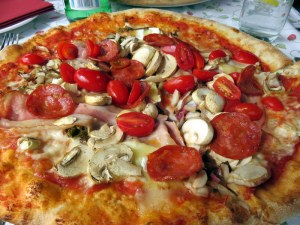19 September 2019.
It is so wonderful to have fine Italian pizza again! Nothing in the U.S. compares, for us. Here, we each eat an entire pizza and while full, we never feel bloated or grotesque. And my jeans still zip the next morning.

The culprit: Pizza Golosa, which means ‘delicious’ or ‘gluttonous.’ Fresh mushrooms and cherry tomatoes with spicy salami and gorgonzola. Ric had a Siciliana with anchovies, capers, and olives.
Italian pizza crust is made from a type of flour that is more digestible. (Ask any Italian about digestibility and you’ll be entertained for hours.) The toppings are fresh and pure and distributed with a light hand. Each ingredient shines on its own and together, well, Mamma mia what a product!
Pizzeria & Steakhouse La Tambra in Santa Cristina is our favorite in the Val Gardena. Usually, we make the trek to La Tambra in the evening catching the infrequent and elusive night bus back to Ortisei. The other day, while tromping around on Monte Pana and Mont de Sëura, we realized that it was almost lunchtime and Santa Cristina was only a chairlift away. Does La Tambra serve pizza at lunch? Turns out they do, and as it was a sunny day, we could dine on the terrace. But what to do after lunch? It was only 14:30 and we certainly could use some steps to retard the growth of fat cells after eating THE WHOLE THING.
Ric’s idea? Walk back to Ortisei on the Sentiero del Trenino. This mostly level path takes one between the towns of Santa Cristina and Ortisei where the WWI supply train ran from 1916-1918. Eventually, it became a tourist train which operated until 1960. This area was part of Austria when the railway was built and was annexed by the Kingdom of Italy after WWI. Some 6000 Russian and Serbian POWs were conscripted to build the line, which they accomplished in only 5 months of brutal day-and-night labor.

Photo from one of the informative panels along the route. 6000 Russian prisoners and 3500 locals were employed in building the WWI rail line to resupply the front. This was Austria at the time.
We started our walk a bit before the official start of the path, launching our pizza-stuffed selves off the terrace of La Tambra and making our way up to the picturesque church in Santa Cristina. The cemetery is stunning and beautifully maintained by the families. Seasonal flowers are planted on each gravesite.
More-or-less beneath the church, a tunnel used by the narrow-gauge train was reopened in 2017 with informative displays about the line. It is well worth a 15-minute detour to walk the 203-meter tunnel and study the displays. The tiny renovated station house (from tourist train days) has short films of the trains in action.
Click any photo for more detail and a slide show.
Continuing on after the church, one heads steeply downhill. We encountered cyclists going both directions but felt exceedingly sorry for one guy who was pushing a pram uphill while his wife struggled along behind. We’ve done this hill in both directions and would vote to go down every time. Ugh!
Then the path levels out and it is a delightful stroll to Ortisei, past farms, playgrounds, and beautiful hotels. Sunny vistas are interspersed with forested sections. The 3 miles passed quickly, taking about 90 minutes including the train tunnel detour.
At least we made a dent in those pizza calories since we are back on the weekly pizza plan during out trip!
Click any photo for more detail and a slide show.







































